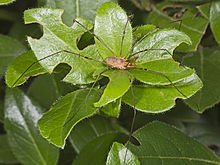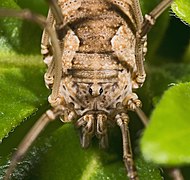Phalangium opilio
| Phalangium opilio | |
|---|---|

| |
| Male Phalangium opilio | |
| Scientific classification | |
| Kingdom: | |
| Phylum: | |
| Class: | |
| Order: | |
| Family: | |
| Genus: | |
| Species: | P. opilio
|
| Binomial name | |
| Phalangium opilio | |
| Synonyms | |
Phalangium opilio is a species of harvestman belonging to the family Phalangiidae.
Distribution[]
It is "the most widespread species of harvestman in the world", occurring natively in Europe, and much of Asia. The species has been introduced to North America, North Africa and New Zealand.[3]
Habitat[]
This species can be found in a wide range of habitats, including meadows, bogs, forests, and various types of anthropogenic habitats, such as gardens, fields, hedgerows, lawns, quarries, green places in built-up areas, walls and bridges.[3]
Description[]
Females have a body length of 6–9 mm (1⁄4–3⁄8 in), males are slightly smaller at 4–7 mm (3⁄16–1⁄4 in). Males however have longer legs; the second leg is about 54 mm (2+1⁄4 in) in males and 38 mm (1+1⁄2 in) in females. Males and females are similarly coloured and marked, although males' markings tend to be less clear. The body has a three-lobed darker "saddle", usually with spots or dashes in the midline. Both sexes show many tubercules with small spikes on the anterior surface of their body.[4]
Mitopus morio has a very similar appearance, but P. opilio can be distinguished by the two pale "denticles" (small teeth-like structures) below the anterior margin of the carapace. Males have long forward-pointing "horns" on the second segment of their chelicerae.[5]
Biology[]
Phalangium opilio is normally an univoltine species and overwinters as eggs. Eggs are laid in moist areas and hatch in three- five months. The immatures undergo several molts and reach maturity in two-three months. These harvestmans usually feed on soft-bodied animals such as aphids, caterpillars, leafhoppers, beetle larvae, mites, but sometime it may scavenge on hard-bodied animals such as various arthropods. [4] They ares also known to feed on Helicoverpa zea eggs, and thus can act as biological pest control for soybean crops. The species is nocturnal, as is typical of opilionids.[6]
Gallery[]
Male showing the "horns" on the chelicerae
Male side view

Female

Female side view
References[]
- ^ Biolib
- ^ GBIF
- ^ a b Tone Novak; Vesna Klokočovnik; Saša Lip ovšek Delakorda; Dušan Devetak; Franc Janželpvoč (2009). "Preferences for different substrates in Phalangium opilio (Opiliones: Phalangiidae) in natural environment" (PDF). . 52 (1): 29–35.
- ^ a b Bugguide
- ^ Jones, Dick (1983), The Countrylife Guide to Spiders of Britain and Northern Europe, Feltham, England: Country Life Books (Hamlyn), p. 310, ISBN 978-0-600-35665-3
- ^ Allard, Cora; Yeargan, Kenneth (September 2005). "Diel activity patterns and microspatial distribution of the harvestman Phalangium opilio (Opiliones, Phalangiidae) in soybeans". The Journal of Arachnology. 33 (3): 745–752. doi:10.1636/T04-17.1. S2CID 85825506. Retrieved 16 October 2020.
| Wikimedia Commons has media related to Phalangium opilio. |
- Harvestmen
- Animals described in 1758
- Arachnids of Africa
- Arachnids of Asia
- Arachnids of Europe
- Arachnids of New Zealand
- Arachnids of North America
- Taxa named by Carl Linnaeus



